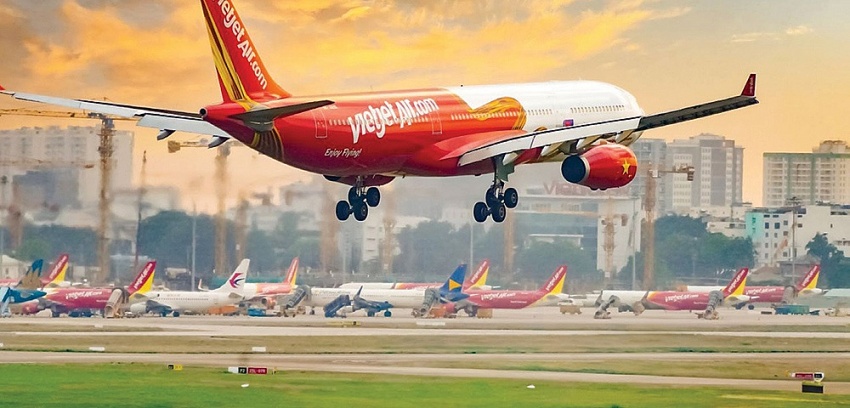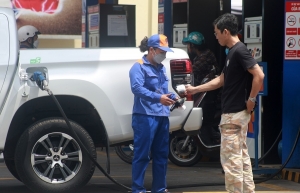Airfare hikes to remain towards 2025
At the end of June, the booking rate for domestic flights was still at a very low level. The average booking rate on flights from Hanoi and Ho Chi Minh City to tourism destinations only reached 50 per cent in recent days, mainly due to expensive airfares.
 |
Recently, airlines have applied solutions to reduce prices. Currently, ticket prices (excluding taxes, fees, and additional service surcharges) on domestic routes range from 30-70 per cent of the maximum prescribed level.
Airlines have increased night flights to reduce costs for both airlines and passengers, but this has not been welcomed. Le Hong Ha, Vietnam Airlines’ CEO, said that the airline had to cancel 10 per cent of night flights in May due to there being few passengers, even though the ticket price was 30 per cent cheaper compared to flying at noon or the afternoon.
“Although flying at night is cheaper, you arrive at a destination at midnight or after, and we have to pay for a night at a hotel without going sightseeing or doing anything,” said Vu Tuyet Nhung, a passenger from Hanoi.
Many travel companies also say that it is too difficult to build tours around night flights and sell them to customers. Nguyen Minh Man, a representative of TST tourist, said that night flights had been deployed by airlines for a long time, but have only been promoted recently due to lack of aircraft and expensive airfares. But flying after 9pm is often suitable for passengers going home or visiting families, not tourists.
“Tourists can save some airfare price, but it raises additional costs. Tourists in summer often travel with their families and have children, so night flights are not good for them. Tourist businesses cannot organise tours to take customers to the destination and then go to sleep,” Man said.
The lack of airline passengers is also affecting tourist destinations. A leader of the Tourism Promotion Centre in the central city of Danang said that domestic tourist numbers have decreased compared to the same period in 2023. In particular, visitors arriving by air have decreased sharply due to very high airfare prices, while the numbers of passengers travelling by train and road have gone up.
Similarly, Nguyen Phi Hong Nguyen, director of Viet Promotion Services and Tourism, said that since the end of April, airfare prices were still high. Currently, airfares from Hanoi to Nha Trang account for about 60 per cent of the tour cost.
“Visitors from northern provinces this summer decreased by half compared to the same period in 2023. Visitors from southern localities such as Ho Chi Minh City, Binh Duong, and Dong Nai prefer travelling by car because there is a new motorway, taking only 5-6 hours,” Nguyen said.
Luu Thi Thu, deputy director of Hoang Viet Travel, hopes to have more daily flights or early morning flights at affordable prices. In the long term, all airlines, travel companies, and localities need to cooperate to provide reasonable-price and high-quality services and products.
“The operation of night flights will be more feasible if there is cooperation from hotels, such as a first night discount for groups flying at night or reduced sightseeing prices for tourists flying at night,” Thu said. “I hope to have adjustments or new policies soon to boost domestic tourism growth this summer.”
Do Xuan Quang, deputy general director of Vietjet, proposed that the government support environmental taxes on petrol, reduce fees for new international routes, and reduce interest rates for the airlines, hotels, and the tourism industry. “We need new policies to support the development of aircraft fleets in Vietnamese airlines, and policies to manage flight slots, and operational activities at airports to increase capacity for the entire aviation industry,” Quang said.
Airfare prices are expected to remain high due to fuel costs, exchange rate differences, and engine recall orders from manufacturer Pratt & Whitney, so the number of aircraft grounded is still increasing, and will only gradually start declining in 2025.
 | Inflation warning ahead of fuel hikes A potential rise in inflation in the second half of the year’s end may be seen following escalating use of electricity and fuel leading to price hikes. |
What the stars mean:
★ Poor ★ ★ Promising ★★★ Good ★★★★ Very good ★★★★★ Exceptional
Related Contents
Latest News
More News
- The destinations powering Vietnam’s festive season travel demand (December 04, 2025 | 18:33)
- Vietnam named among the world’s most exciting winter destinations (December 04, 2025 | 15:10)
- Phu Tho emerges as northern Vietnam’s new tourism hub (December 01, 2025 | 17:00)
- Vietjet completes Airbus A320/A321 updates ahead of deadline (December 01, 2025 | 09:49)
- Vietjet resumes Con Dao flights from early December (November 28, 2025 | 15:24)
- Free tickets, Lunar New Year promotions on offer at Vietjet Mega Livestream (November 26, 2025 | 15:32)
- Scandinavian Airlines and Vietnam Airlines broaden agreement with new routes (November 25, 2025 | 17:04)
- Halong Cruise Port welcomes over 3,100 international visitors (November 12, 2025 | 18:06)
- Vietnam.travel climbs to second place in Southeast Asia website rankings (November 12, 2025 | 18:01)
- Cat Ba named among Southeast Asia’s top island adventures (November 11, 2025 | 18:09)

 Tag:
Tag:



















 Mobile Version
Mobile Version